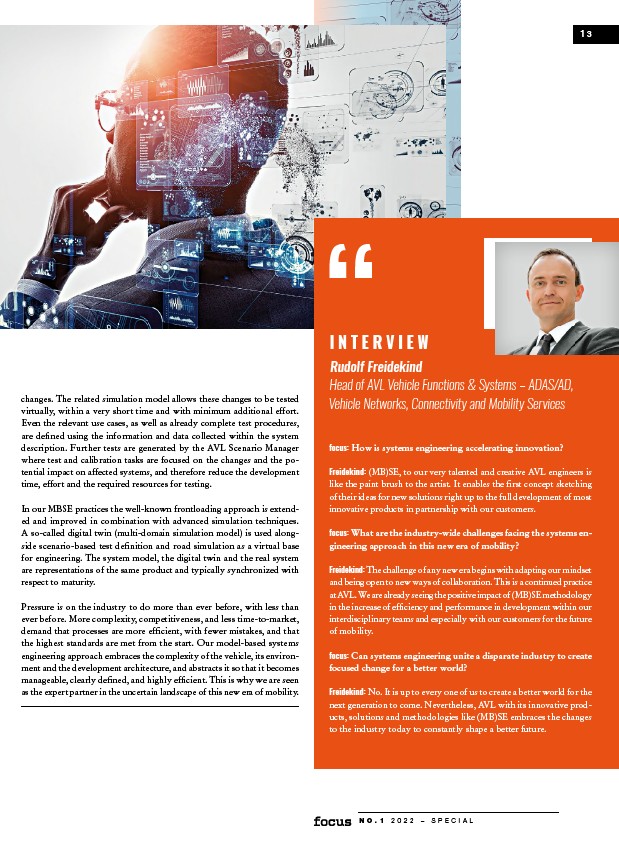
“
I N T E R V I E W
Rudolf Freidekind
Head of AVL Vehicle Functions & Systems – ADAS/AD,
Vehicle Networks, Connectivity and Mobility Services
focus: How is systems engineering accelerating innovation?
Freidekind: (MB)SE, to our very talented and creative AVL engineers is
like the paint brush to the artist. It enables the first concept sketching
of their ideas for new solutions right up to the full development of most
innovative products in partnership with our customers.
focus: What are the industry-wide challenges facing the systems en-gineering
approach in this new era of mobility?
Freidekind: The challenge of any new era begins with adapting our mindset
and being open to new ways of collaboration. This is a continued practice
at AVL. We are already seeing the positive impact of (MB)SE methodology
in the increase of efficiency and performance in development within our
interdisciplinary teams and especially with our customers for the future
of mobility.
focus: Can systems engineering unite a disparate industry to create
focused change for a better world?
Freidekind: No. It is up to every one of us to create a better world for the
next generation to come. Nevertheless, AVL with its innovative prod-ucts,
solutions and methodologies like (MB)SE embraces the changes
to the industry today to constantly shape a better future.
changes. The related simulation model allows these changes to be tested
virtually, within a very short time and with minimum additional effort.
Even the relevant use cases, as well as already complete test procedures,
are defined using the information and data collected within the system
description. Further tests are generated by the AVL Scenario Manager
where test and calibration tasks are focused on the changes and the po-tential
impact on affected systems, and therefore reduce the development
time, effort and the required resources for testing.
In our MBSE practices the well-known frontloading approach is extend-ed
and improved in combination with advanced simulation techniques.
A so-called digital twin (multi-domain simulation model) is used along-side
scenario-based test definition and road simulation as a virtual base
for engineering. The system model, the digital twin and the real system
are representations of the same product and typically synchronized with
respect to maturity.
Pressure is on the industry to do more than ever before, with less than
ever before. More complexity, competitiveness, and less time-to-market,
demand that processes are more efficient, with fewer mistakes, and that
the highest standards are met from the start. Our model-based systems
engineering approach embraces the complexity of the vehicle, its environ-ment
and the development architecture, and abstracts it so that it becomes
manageable, clearly defined, and highly efficient. This is why we are seen
as the expert partner in the uncertain landscape of this new era of mobility.
1 3
N O . 1 2 0 2 2 – S P E C I A L